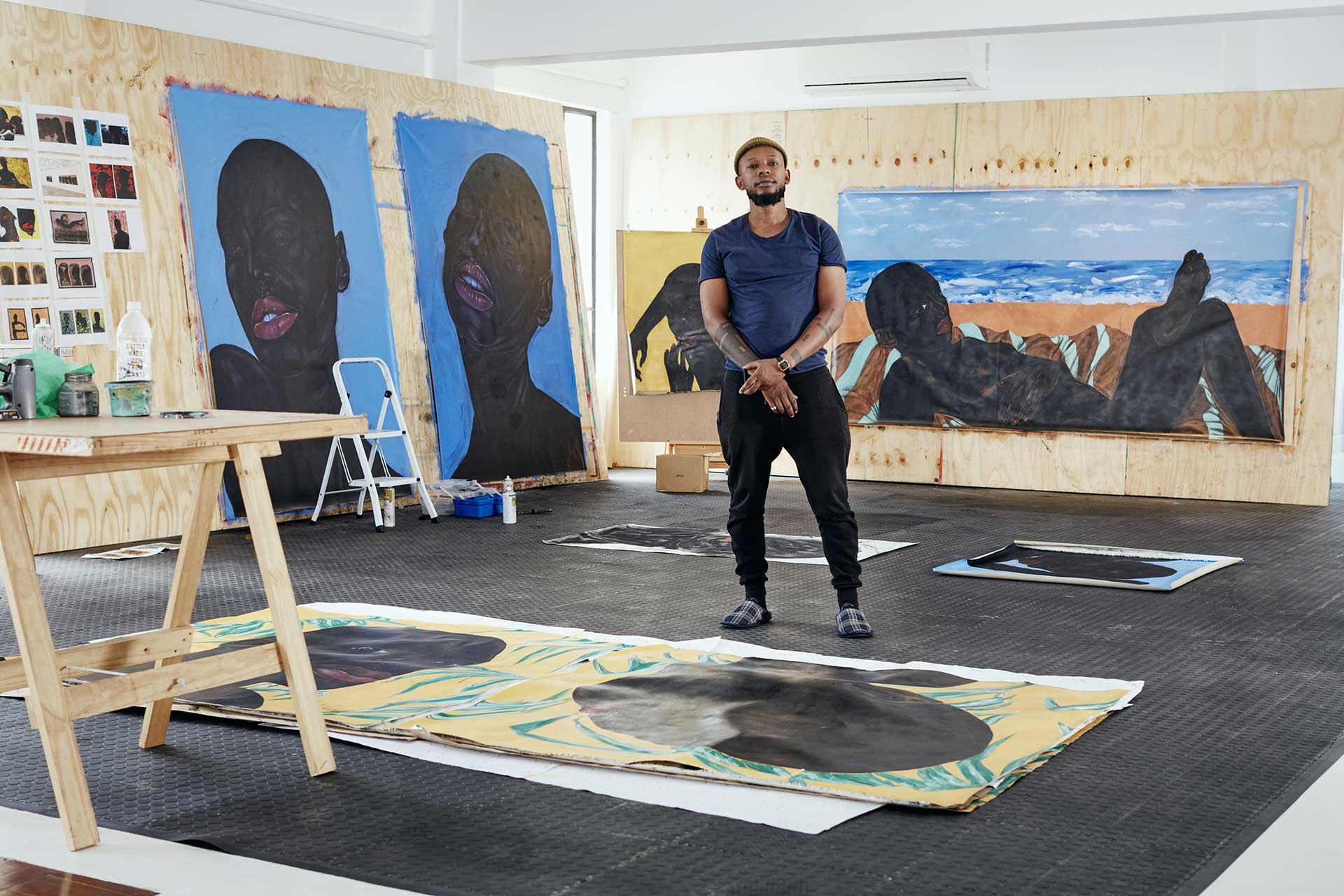Southern Guild presents Who We Should Not Be, a solo exhibition of mixed-media portraits by Navel Seakamela, running from 22 June to 28 July, 2022. The artist reflects on the role of leisure in this series of large-scale works depicting people in moments of quietude, repose and vulnerability. Who We Should Not Be contemplates both the joys and difficulties of existence in a world where bodies are inscribed with meaning, read and misread. This body of work, Seakamela’s first solo with the gallery, was completed while he was the first artist in residence at the GUILD Residency. Throughout his artistic career, Seakamela has developed a distinct visual language. His approach to telling stories is intuitive and compresses various sensibilities and feelings into a single clean frame —uncluttered, measured, almost bare. The central chorus of Who We Should Not Be is harmonised around a series of paintings bathed in golden yellow, accompanied by fronds that droop lazily and lounging bodies completely at peace with themselves. For Seakamela, this golden yellow gestures towards the many possibilities of being — not only as a reflection of light but also a reflection on the lightness of being. He leans into this yellow (accentuated by the darkness of the skin) to transport us towards the magical and the sacred Within these works the arrangement of form and colour is unified into a single tableau conveying the feeling of ease. Fragments of leaves bring to mind the image of palm trees, which in turn evoke the spirit of elsewhere and function as a potent symbol of leisure.
In another set of images, Seakamela leans into the colour red. A red that seems endless. A figure rests against a red background in a state of contentment. Beyond the bust, the image is devoid of any markers of place, expanding the possibilities of being. Who is this character? Where are they? And what are they doing? Seakamela holds on to opacity leaving us only with red. Who We Should Not Be is a contemplation on the lightness and darkness that defines our reality – be it in the hefty task of navigating expectations of how we should be in the world or the extraordinary weightlessness that comes with letting go. Through this work, the body — or at least the depiction of it — becomes a way to think about consciousness and the political, recalling Anne Truitt’s sentiment in her 1982 Daybook that “consciousness seems to me increasingly inconceivable. I know more and more that I know nothing of its nature, range, and force except what I experience through the slot of this physical body.”
In a similar sense, Seakamela signifies life through the portrayal of the physical body. But of course he is, to an extent, depicting himself or at least an aspect of himself because we can never be outside of ourselves. On occasion of his 2020 exhibition, What is a Head?, curator Michael Peppiatt refers to this as a form of looking at oneself, noting that “figurative art continues to be powerful because it’s a form of yourself looking back at you. And that puts you on the spot. It’s like looking at a deformed mirror.” For Seakamela, portraiture is a way of capturing human emotion and digging deep into one’s own subconscious. In Who We Should Not Be, exaggerated portraits become a way for him to reflect on a sense of self through tender representations of love and courage in relation to others. Moments of grace and beauty take hold through a careful unfolding of gestures — a hand on the bare body, eyes shut tight inspiring a dreamlike state, eyes resting on a loved one. Painting is always fraught with difficult questions of representation — who is represented and why – nevertheless, we build our own worlds within this existing one. Who We Should Not Be is not removed from this historical context; in fact, its cogency lies within that context and should be read in that light. The portrayal of black bodies at rest refuses racist traditions that continue to render black bodies invisible. Within this work, the intimate and the political converge in a deeply meaningful way.
Read more +
Read less -







 Sign in with email
Sign in with email






